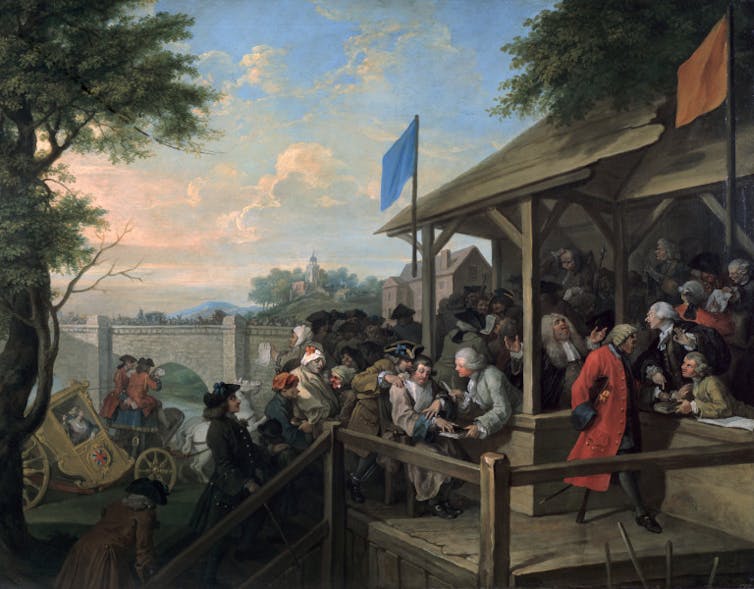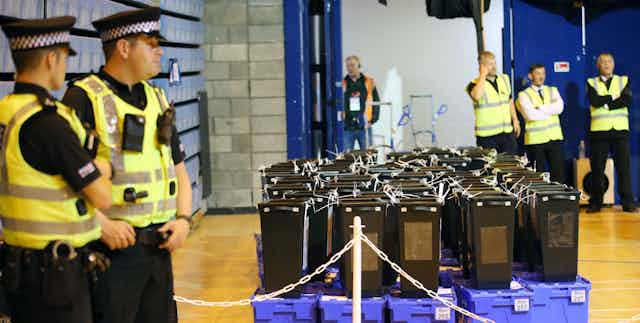William Hogarth’s painting The Polling is the iconic depiction of an election day in Britain. Painted in the 18th century, it was one of four canvasses that formed a series called The Humours of an Election (1754-5), all inspired by an Oxfordshire election, where the Whigs took on a safe Tory seat.
The Polling captures the unscrupulous tactics being used by both sides to win the contest at a time where there was no secret ballot – or even an electoral register. The electorate was small and votes were generally by a show of hands. If a more formal poll was required, then the returning officer would have a book into which each voter’s name and qualification was stated.

Hogarth captured the parties bringing forward anyone they could to vote, pushing procedure aside if needed. A man with an amputated hand is being challenged because he is placing his hook, rather than his hand as legally prescribed, on the book. The ill and infirm are being dragged forward. In the background, a coach that seems to contain Britannia has collapsed, but this is unnoticed in the chaos.
What should a modern day Hogarth paint for election today? Some would etch an image of corruption and chaos. Conservative peer Eric Pickles, giving evidence in parliament, described election day as being “of warm beer and old maids cycling to evensong. It is largely built on trust”. He described a system that operates as it has always done, on the false assumption that it doesn’t need to be much changed. “It is,” he said, “ripe for the taking”, suggesting that the system is so lax that voters could (and would) pretend to be someone else and vote twice, thrice or more.
The former Conservative Party chairman, whose “independent” report on electoral fraud has shaped the government’s approach to reforming the way elections are run, has often sought to highlight the isolated but headline-grabbing cases of electoral fraud that have taken place in the UK over the years, such as an incident in East London’s Tower Hamlets in 2014.
Pickles has also concentrated the public’s eye by claiming that electoral fraud is a problem “especially in communities of Pakistani and Bangladeshi background”. The problem has not been tackled, he argued, because of “over-sensitivities about ethnicity and religion”. His 50-point plan for tackling election fraud included the headline measure of compulsory voter identification requirements for all.
The view from the ground
The evidence, however, is that a modern depiction of elections should not be framed in this way. A newly published study from Alistair Clark and I shows that electoral fraud in polling stations is not a problem that we need worry about right now. Research, including this recent work on the experiences of more than 5,000 polling officials in the 2018 and 2019 local elections, shows that it is exceptionally rare for people to impersonate someone to try to vote. There are hardly any cases of the “problem” which a voter ID would “solve”.
Election day, in fact, tends to go smoothly, and as a whole, elections are well run.
But they are not problem free. The most common issues relate to registration. Most polling stations turn away at least one would-be voter because they were not on the register. This is sometimes because they have gone to the wrong polling station, but also because they have paid their council tax so intuitively, but incorrectly, think – “I must be registered”.
There are problems with accessibility issues. Disabled voters often cannot access polling stations or complete ballot papers. This might be because of steep steps, scaffolding preventing wheelchairs and buggies, or a lack of parking. There are problems with the behaviour of agents who can too aggressively enquire as to who the voter is, which some find off putting. While the vast majority of election staff are polite, collegial and hard-working, there are the occasional employees who have the “manners of a pig”, to quote one.
And there are problems with the behaviour of voters. This can range from the unnerving, but usually comical drunk, coming to vote before last orders, through to loud shouting in polling stations, where “men instruct women” how to vote.
Contrary to many suggestions, however, our research found no evidence that any problems were of a greater concentration in Bangladeshi or Pakistani origin communities. We looked. Problems might be more common in urban areas, but they were not linked to specific communities. Men giving guidance to women as to how they should vote is a gender problem – endemic throughout Britain – not related to ethnicity.
A comparison against similar countries shows that citizens do not have the same level of service as other voters – not because of the lack of efforts from electoral officials – but because electoral law remains wedded to the Victorian era. There is no effective method for citizens to complain if they experience a problem. They can’t register on the day if there has been a technical issue. They are not automatically registered when they access other government services. Elections also receive much less financial investment.
Repainting British elections
The title of the “modern Hogarth” has already been awarded to artist Cold War Steve and he would be best placed to paint a modern version of The Polling.
Such an image might include Pickles himself (or members of the current government), standing outside a polling station unnecessarily asking citizens to show their IDs before they can vote. It should remove from our mind the image of elections being undermined by personation and fraud – and challenge the idea that fraud is concentrated in some communities.
The problems are with voter registration, accessibility and polling station behaviour – and people like Pickles misrepresenting problems. Any future government should make it a priority to redraw elections using by updating some Victorian practices that remain.


